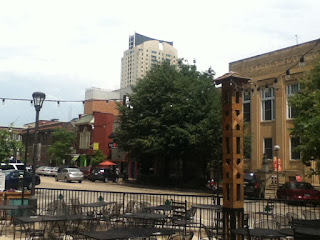Cedar Rapids is not unique in seeking to leverage its health care cluster to promote prosperity for the city. A quick Internet search finds Baltimore, Birmingham, Boston, Buffalo, Camden, Cleveland, Detroit, Pittsburgh, Philadelphia and Poughkeepsie pursuing some version of the "eds and meds" strategy. The closest role model for us is Rochester, Minnesota, a town slightly smaller than Cedar Rapids (112k vs. 129k) but world renowned for the Mayo Clinic, a mega-hospital employing about six times the combined work force of St. Luke's and Mercy Hospitals in Cedar Rapids.
(Strange to say, Rochester, too, only considers itself an aspiring healthcare destination: Its 2010 Downtown Master Plan stated one of its goals was to "[s]upport the Destination Medical Community goal to provide an ideal experience for patients and visitors" (p. 29) and a state law passed in 2013 aims at facilitating its becoming a Destination Medical Center. Ummm... with a million patients a year coming from 150 countries it isn't already one?)
 |
| Well, there's your problem. You call these banners? |
The Mayo Clinic is thoroughly integrated into the downtown area. Some might say it pretty much is the downtown area.
 |
| Rochester Methodist Hospital used to be separate but merged with Mayo some time ago. Another large Mayo facility, St. Mary's, is a few blocks west. |
There are stores facing the street, as in the picture above, as well as in a "subway" accessible through the Kahler and Marriot hotels. Some of what's there:
By the way, directional signage, one of the goals of the MedQuarter, could be a lot better in Mayoland. When a confused, tentative out-of-towner wanders across the path of a doctor on a 20-minute lunch break, danger lurks.
The existence of both the subway and a skywalk system did not preclude pretty vigorous activity on the street, at least at mid-day with weather that was mostly good:
The Peace Plaza is a block of 2nd Street SW, east of the main clinic building, that has been closed to traffic:
Besides the Peace Plaza, though, Rochester hasn't pursued the sort of recreational amenities envisioned by the MedQuarter plan. There are trails along the nearby Zumbro River, and an intended Riverfront and Arts District (pp. 79-83), and some substantial city parks nearby, but not in the immediate vicinity of the clinic itself.
What is the impact of the medical complex on its surroundings? One block south of Mayo on 1st Street SW, we are still in the world of small restaurants and shops. This is the old City Hall, by the way; the current facility is across the river.
Another block away, and it's emptying out...
Beyond 4th Avenue, it's really empty, just like the edges of Cedar Rapids's MedQuarter are. Rochester's medical/downtown area is intense and urban, but quite contained. The Downtown Master Plan notes, "the fringe areas between Downtown and [nearby] residential zones often exhibit a pattern of development, including many blocks of surface parking lots, which does not provide either a gentle transition from Downtown or a strong edge" (p. 31).
So what have we learned from our investigative race through Rochester? Maybe nothing. If Cedar Rapids does achieve its goal of becoming a medical destination, it neither means we get what Rochester has, nor that what Rochester now has somehow limits what Cedar Rapids could build.
Most importantly, the contrast of urban and suburban patterns of development surely results from design choices made long ago. Rochester's medical complex is clustered in a high-density way; Cedar Rapids's medical buildings stand alone surrounded by many acres of surface parking.
If the SSMID's plans for the MedQuarter go forward, it will reproduce suburban design albeit will be way more attractive than what's there now. I believe this has less to do with the Mayo Clinic's greater size than with design choices long in place. I do not have a business brain, and can only speculate that it's because of these contrasting legacies that, with 1/6 the medical employment of Rochester, downtown Cedar Rapids has much less than 1/6 the ancillary businesses. In the MedQuarter itself, it might be 1/600.
Another thing critical mass allows is some imaginative thinking about public transportation. Rochester's comprehensive plan, adopted this year, envisions the need for serious investment in buses in order to meet anticipated growth. Mayo anticipates it will continue to grow: "It is expected that this expansion will happen both within and outside downtown, with non-essential functions relocating out of downtown [to] key growth areas to the south and west. In tandem with this change, Mayo is focused on critical transportation solutions for staff and patients" (p. 28). This is one important way in which contributing to the strength of the community as a while contributes to the strength of the medical enterprises.
The MedQuarter plan, too, expresses the intent to "contribute to the growth of Cedar Rapids," in three specific ways (p. 3):
- Respectfully integrate MedQuarter development with adjacent neighborhoods and districts
- Clearly define the role of public and private sector interests and continue to strengthen private-sector control and accountability to carry out enhanced public services
- Elevate the MedQuarter and the City as a whole by establishing a unique district character and environment attractive in the recruitment and retention of medical business and ancillary uses













Sioux Falls fancies itself a medical destination, also, and may be a more accurate comparison to Cedar Rapids than Rochester.
ReplyDelete